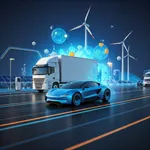My Electric Journey:
1.5 Years Behind the Wheel
Driving an electric vehicle for the past 1.5 years has been a journey of adaptation and discovery. While my car’s limited charging capacity has kept me from long-distance trips, it’s been a joy for shorter drives within a 300-350km range. The smooth acceleration and quiet ride have won me over, even if I remain skeptical about Germany’s ability to meet rising electricity demands. However, stories like those from the Elektrotrucker and advancements in autonomous driving give me hope for an exciting future. In this article, I’ll share my experiences, challenges, and optimism about the evolving world of electric vehicles.
Android’s Notification Limit:
A Hidden Quirk and My DIY Fix
I recently encountered a frustrating issue with my surveillance camera app: after a certain time, it stopped receiving notifications. After reaching out to the developer multiple times without success, I stumbled upon a little-known Android quirk—the platform limits the number of notifications an app can display to 24. Once this limit is reached, no new notifications come through. As a temporary fix, I built a small app to automatically clear old notifications, ensuring I never miss an alert. In this article, I’ll share my journey of discovering this limitation and the DIY solution I created to work around it.
The Power of Pragmatism
in Software Development
In my years in the software industry, I’ve met many talented individuals, but the ones who stand out share a common trait: pragmatism. They’ve seen it all, learned from experience, and aren’t afraid to break the rules when necessary. Instead of pushing rigid opinions, they help others find their own solutions, offering guidance and alternatives without imposing dogma. In this article, I’ll discuss why individuality and flexibility are crucial for solving problems, fostering growth, and navigating the ever-changing landscape of software development.
My Dilemma with
Modern Programming Languages
Over the past 30 years, I’ve seen programming languages evolve from niche tools for enthusiasts to mainstream technologies driven by speed and convenience. While I still love Go for its simplicity and tooling, and C for its control and transparency, the rise of Rust and Zig has introduced new contenders. Rust, with its growing ecosystem and adoption in major systems, is often hailed as the ultimate language. Zig, on the other hand, offers minimalism and a powerful compiler. In this article, I’ll share my thoughts on these languages, the challenges of modern programming culture, and why I continue to value the classics like Go and C.
Balancing DX and Web Standards:
My Experience with Astro and Lit
When working with web standards, it’s easy to assume that developer experience (DX) will suffer without the conveniences of large frameworks. In a recent internal project, I decided to forgo frameworks entirely, using Lit with JavaScript. While this approach eliminated the need for a build environment, it introduced challenges like repetitive HTML templating and the need for a bundler. Enter Astro—a tool that not only provides excellent HTML templating but also a robust build environment for JavaScript and CSS. In this article, I’ll share how combining Astro and Lit has improved my productivity and why modern web standards, paired with the right tools, can rival the DX of large frameworks.




